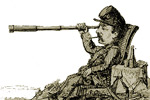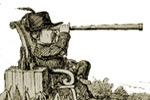|
|
1851
February 26
|
Albert James Myer earned his Doctor of Medicine degree.
His doctoral dissertation, “A New Sign Language for Deaf Mutes,” proposed
a system of sign writing based on the Bain telegraphic alphabet. |
| |
1854
January
|
Myer passed the Army medical board examination,
earning an appointment as an assistant surgeon in the Medical Corps. |
| |
1856
October 1 |
Myer proposed for War Department consideration
a system of battlefield communication based on a combination of standard
sign language and the telegraphic alphabet. His “wigwag” visual communication
system, patented earlier in the year, employed daytime flags and nighttime
torches to correspond between Army posts situated as far apart as 10 miles. |
| |
1860
June 21 |
President James Buchanan signed an appropriations
bill authorizing the “purchase of apparatus and equipment for field signals”
and the appointment of a signal officer to the U.S. Army. |
| |
1860
June 27 |
The U.S. Senate confirmed the appointment of Albert
James Myer as signal officer with the rank of Major. |
| |
1860
October |
Major Albert James Myer began a field training
program for officers in Santa Fe, New Mexico, in signals communication during
the U.S. Army’s frontier campaign against the Navajo Indian Nation. |
| |
1861
February |
Following the Navajo surrender, campaign commander
Colonel Thomas T. Fauntleroy reported that “the services of the Signal Party
have been valuable . . . and have conclusively demonstrated not only the
usefulness of field signals but that they can be used under any of the contingencies
of frontier warfare.” |
| |
1861
March-April |
As the United States became embroiled in Civil
War, Major Myer began training a contingent of soldiers in the skill of
signals at Fort Monroe, Virginia. Simultaneously, Captain Edward P. Alexander,
trained in signals communication by Myer himself, organized a provisional
Signal Corps for the Army of the Confederacy. |
| |
1861
June 12 |
The U.S. Army detailed its first combat signal
units at Fort Monroe for service with the Union Army against Confederate
forces. |
| |
1861
June 15 |
Considered the first use of signals in combat,
Union signal officers directed cannon fire on the Confederate works at Sewell’s
Point by the Fort Calhoun (later Fort Wool) battery at Hampton Roads, Virginia.
A signal detail, including Major Myer, observed the effect of this
assault from a tugboat and reported observations to the shore battery using
signal flags. |
| |
1861
June 26
|
Myer established a permanent line of communication
(using flags and torches) between Fort Monroe and the Union detachment at
Newport News, Virginia. |
| |
1861
July 10 |
Myer instituted his first signal school at Fort
Monroe, Virginia. |
| |
1861
July 21 |
While Union forces at the First Battle of Bull
Run (also First Manassas) opted for airborne balloon intelligence to monitor
enemy troop movements (an idea that literally never got off the ground),
the Confederate Army enjoyed the more reliable communication services of
Captain E.P. Alexander’s signals. Signals intelligence proved decisive in
the Confederate victory. |
| |
1861
August 14
|
While Alexander won promotion to Confederate Army
Chief of Ordnance, Myer won the attention of the Union War Department and
authority to man and equip “a system of signals along the line of the Potomac
through Maryland, connecting the column under Major General Banks and those
under Brigadier Generals Stone and McCall. . . .” That authority also extended
to Major Myer’s acquisition of the “flying telegraph train,” a train of
horse-drawn wagons equipped with magneto-electric telegraph sets, field
wire, flags, rockets, and sundry equipment needed to service the Union’s
Potomac signal system. |
| |
1861
August 30
|
Major Myer instituted a Union Army Camp of Instruction
for 18 signal officers and 45 enlisted members of the Acting Signal Corps
at Red Hill, Georgetown, D.C. At that time, all Corps members were detailed
from regular elements of the army; they were not permanently assigned. By
January 1862, the number of officers increased to 105 while the number of
enlisted rose to 212. This dramatic rise in Signal Corps strength illustrated
the War Department’s post-Bull Run perception of the signal system’s tactical
advantage on the battlefield. |
| |
1861
November 5 |
Major Myer established the Office of the Chief
Signal Officer at No. 158 F Street, N.W., Washington, D.C., to administer
the clerical and financial aspects of his fledgling organization. |
| |
1862
January 1 |
Union army and navy forces employed Major Myer’s
signal system during a joint land and sea attack on Port Royal Ferry where
Federal troops first touched the mainland of South Carolina. Signal flags
directed effective fire from Union gunboats and coordinated communication
between Union vessels and joint service shore parties. The Union Naval Academy
at Newport, Rhode Island adopted Myer’s code of signals based on the Port
Royal Ferry experience. |
| |
1862
March ? –
1863
July |
During the long Union campaign to control the Mississippi
River from New Orleans to Vicksburg, a Union signal party served effectively
with the Marine Brigade and with elements of the Union navy. After the fall
of New Orleans in 1862, the signal party continued such effective action
that it was cited for service under fire during the attack and fall of Memphis
in June, 1862, and Vicksburg in July, 1863. |
| |
1862
March 9 |
During the naval battle between the Monitor and
the Merrimac at Hampton Roads, Virginia, a Confederate army signalman aboard
the Merrimac (aka the Virginia) relayed messages by flag and torch to a
shore based signal party. This was the first use of an army signalman on
board a naval warship. Subsequently, signal officers accompanied almost
all blockade-runners of the Confederate navy. |
| |
1862
April |
The Confederate Congress authorized the establishment
of a regular Signal Corps, a full year before the U.S. Congress passed such
legislation for a Union Signal Corps. Nevertheless, the Confederate Corps
never achieved the dimensions of the Unions Acting Signal Corps in either
manpower or equipment. |
| |
1862
June 1
|
Using a telegraph instrument aboard a captive balloon
during the Battle of Fair Oaks, a Union observer reported his aerial observations
of Confederate troop movements. This marked the first use of telegraphy
from an airborne platform and the first air-to-ground communications of
the Civil War. |
| |
1863
March 3 |
Congress passed legislation to authorize a regular,
rather than acting, Union Signal Corps for the duration of the Civil War. |
| |
1863
July 3
|
Union signal stations atop Big Round Top and Little
Round Top mountain peaks observed Confederate force deployment and communicated
enemy movements to Union battle commanders at the Battle of Gettysburg.
While many factors contributed to Union victory, signals intelligence proved
instrumental in the defeat of the Confederate army at Gettysburg. |
| |
1863
August |
In the fall of 1863, Myer invented and instituted
the use of a signal cipher disc to counter recent Confederate interception
of Union signals. A Confederate secret service operator soon broke the Union
cipher disc code, however, and cipher code changing became a routine practice
among both Union and Confederate forces. |
| |
1863
November
|
Secretary of War, Edwin Stanton, replaced Myer
as Chief Signal Officer, with LTC William Nicodemus, who served as acting
Chief of Signal until succeeded on 26 December by Colonel Benjamin F. Fisher. |
| |
| 1864 |
Myer wrote and published his Manual of Signals. |
| |
1866
July 28 |
On the endorsements of Generals Sherman, Sheridan,
Thomas, and Grant, Colonel Myer achieved reinstatement as Chief of Signal. |
| |
1867
October
|
Functioning as a supply agency, the Signal Corps
furnished two full sets of signaling equipment and two copies of the Manual
of Signals to every company and post of the Army. Telescopes and binoculars
were also furnished by requisition. All signal equipment came under the
accountability of the Chief of Signal. |
| |
1870
February 9
|
The War Department, after receiving a Congressional
mandate, made the Signal Corps responsible for weather forecasting. The
Signal Corps erected weather stations, connected by telegraph wires, throughout
the nation to provide meteorological data. This work continued until 1891
when the Department of Agriculture assumed responsibility for all non-military
meteorology. |
| |
1877
August
|
The Signal Corps developed the military heliograph
at Fort Whipple (later Fort Myer), Virginia. Although its effective range
in clear weather exceeded 30 miles, it was not adopted for extensive use
for nearly 10 years. In the mid-1880s the Army used the heliograph during
Indian campaigns in the Southwest to link isolated forts and outposts. One
of these, Fort Huachuca (later home of the U.S. Army Signal Command) was
connected into an elaborate network of heliograph communication stations. |
| |
1877
October |
Less than two years after Bell’s invention of the
telephone, the Signal Corps fielded the military version of the new communications
device. By spring 1878, the Corps had constructed a 40-mile telephone line
along two iron wires. |
| |
1878
July
|
The Signal Corps first experimented, with only
limited success, in the use of homing pigeons. |
| |
1880
August 24
|
Brigadier General Albert J. Myer died at age 52.
A year later, the Army renamed Fort Whipple, Virginia, Fort Myer in his
honor. |
| |
1880
15 December
|
Brigadier General William B. Hazen won appointment
as Army Chief Signal Officer. |
| |





